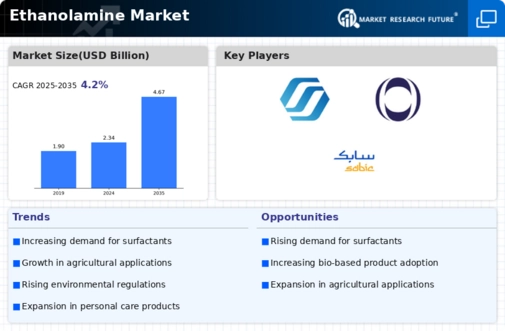Market Share
Ethanolamine Market Share Analysis
In the Ethanolamine Market, companies employ diverse strategies to secure and enhance their market share. Here's a breakdown of key positioning strategies:
Product Diversification:
Companies aim to differentiate their ethanolamines by offering a diverse range of products tailored to various applications, such as surfactants, herbicides, or pharmaceuticals.
Developing specialized formulations with unique properties, such as enhanced solubility, stability, or purity, to meet specific customer requirements and address niche markets.
Expanding product lines to include different grades or concentrations of ethanolamines to cater to a wider spectrum of industries and applications.
Market Segmentation:
Segmenting the market based on end-use industries, such as agriculture, personal care, or chemical manufacturing, to better understand and address distinct customer needs.
Tailoring marketing strategies and product offerings to target specific market segments effectively, maximizing market penetration and revenue generation.
Developing customized solutions for niche markets or applications, such as specialty ethanolamines for the production of agrochemicals or detergents.
Brand Positioning:
Building a strong brand reputation by emphasizing factors such as product quality, reliability, and technical expertise.
Investing in marketing initiatives to raise brand awareness and differentiate from competitors, including advertising campaigns, participation in industry events, and online presence.
Establishing partnerships with key industry players or certification bodies to enhance brand credibility and trust among customers.
Cost Competitiveness:
Striving to achieve cost leadership by optimizing production processes, sourcing raw materials efficiently, and minimizing operational expenses.
Offering competitive pricing strategies to attract price-conscious customers while maintaining profitability through economies of scale and operational efficiencies.
Providing value-added services or bundled solutions to justify premium pricing in segments where customers prioritize quality, reliability, and technical support.
Technological Innovation:
Investing in research and development to innovate and improve ethanolamine production processes, resulting in cost savings, efficiency gains, and product performance enhancements.
Leveraging advancements in technology to develop novel applications or formulations of ethanolamines, expanding market opportunities and gaining a competitive edge.
Collaborating with research institutions or industry partners to stay at the forefront of technological advancements and drive product innovation.
Regulatory Compliance and Sustainability:
Ensuring compliance with regulatory requirements and industry standards regarding product safety, quality, and environmental impact.
Investing in sustainable manufacturing practices, such as waste reduction, energy efficiency, and recycling initiatives, to minimize environmental footprint and meet growing consumer demand for eco-friendly products.
Communicating sustainability initiatives and certifications to customers to enhance brand reputation and capture market share in environmentally conscious segments.






Leave a Comment